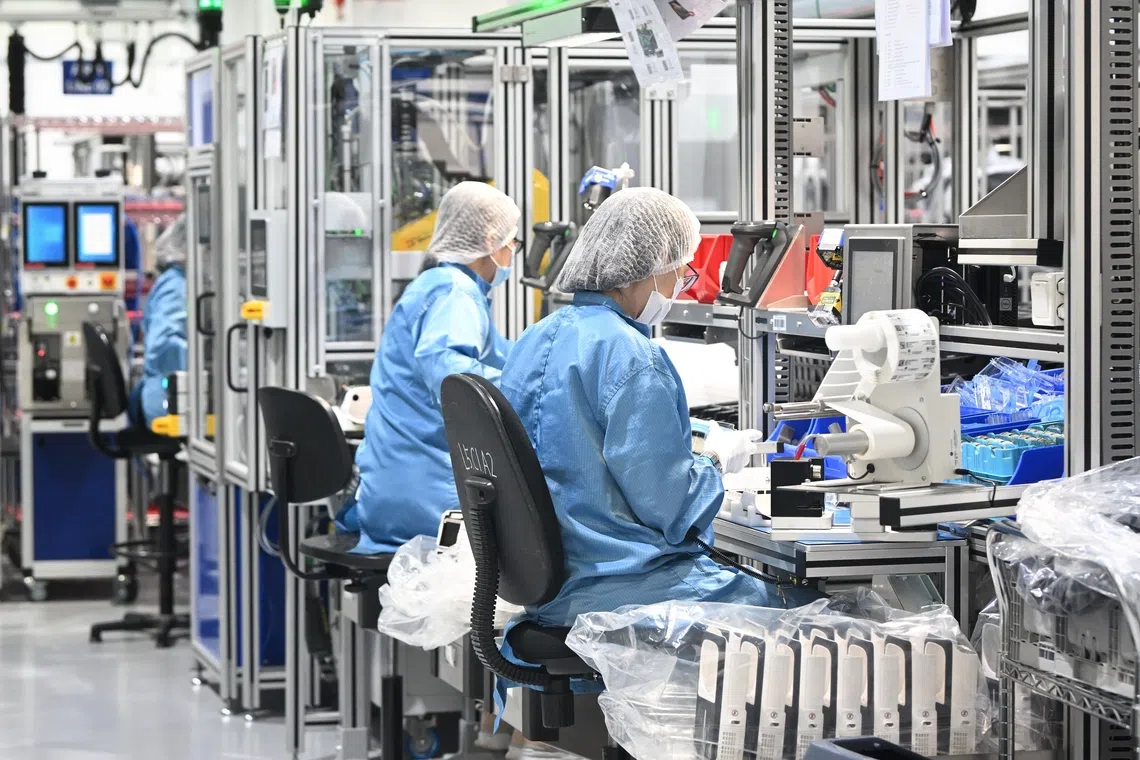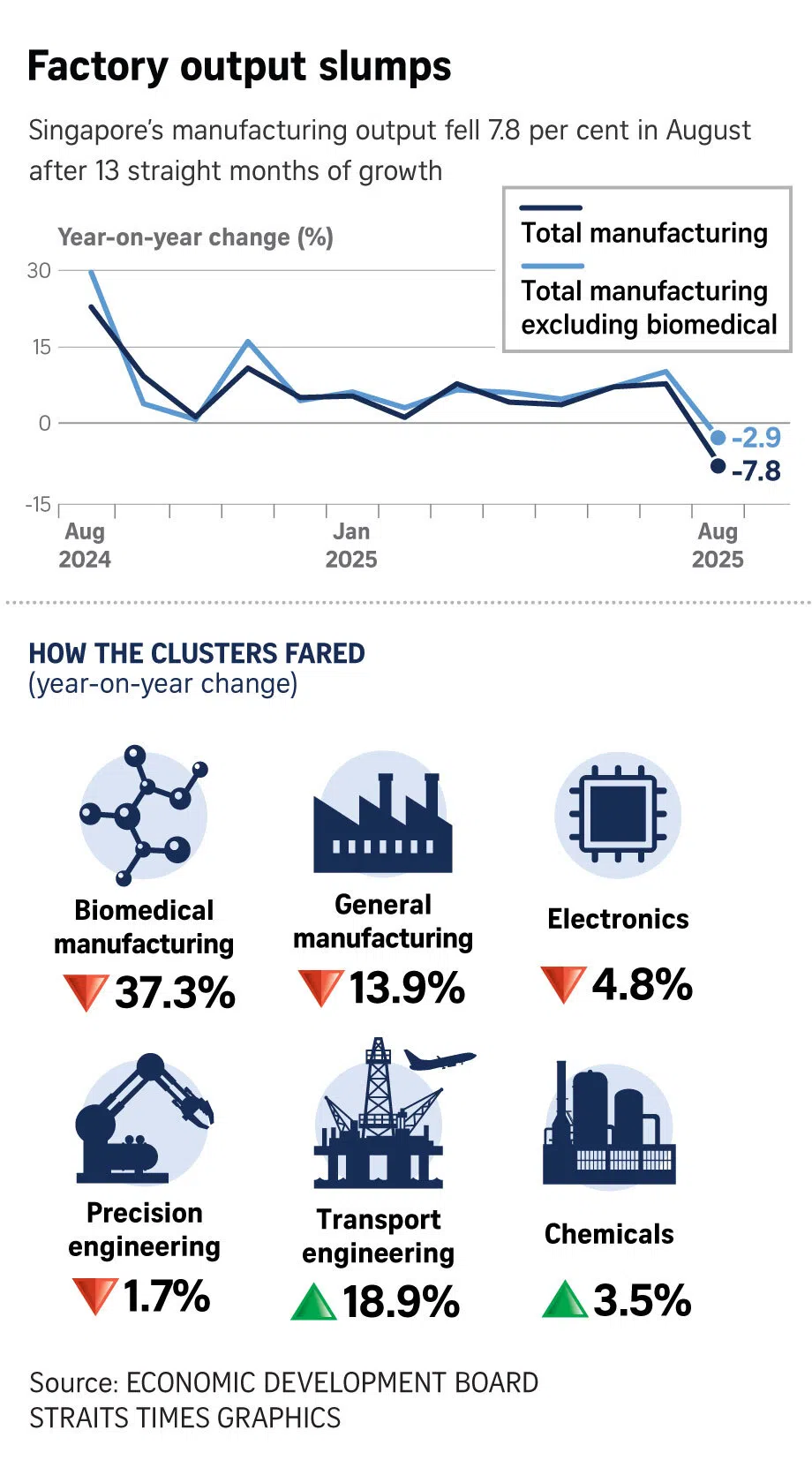Singapore factory output turns negative in August, shrinks 7.8% under US tariff cloud
Sign up now: Get ST's newsletters delivered to your inbox

The drop in production was worse than the 1.9 per cent decline forecast by economists in a Bloomberg poll.
PHOTO: ST FILE
Follow topic:
SINGAPORE – Singapore’s manufacturing output fell in August, snapping 13 straight months of growth, as key pharmaceutical and electronics production shrank.
Analysts said export-driven manufacturers here will struggle as overseas shipments continue to weaken with higher US tariffs on more than 90 countries taking effect on Aug 7.
In his latest salvo, US President Donald Trump on Sept 25 announced a 100 per cent tariff on branded or patented pharmaceutical imports from Oct 1. He is also expected to announce tariffs on semiconductors.
Singapore’s total factory output dropped 7.8 per cent in August from a year ago, reversing from a revised 7.7 per cent rise in July, according to data released by the Economic Development Board. This was far worse than the 1.9 per cent decline forecast by economists in a Bloomberg poll .
Excluding the more volatile biomedical industry, production fell 2.9 per cent.
On a seasonally adjusted month-on-month basis, manufacturing output slid 9.7 per cent. Excluding biomedical manufacturing, it slipped 3.5 per cent.
Biomedical manufacturing was the hardest hit, recording a 37.3 per cent year-on-year contraction.
The pharmaceuticals segment in particular saw a 59.3 per cent drop from a high base in 2024, due to a different mix of pharmaceutical ingredients being produced.
On the other hand, the medical technology segment grew 5.3 per cent on the back of sustained export demand for medical devices.
Mr Chua Han Teng, a senior economist at DBS Bank, said manufacturing performance is likely to be volatile for the remainder of 2025, as Singapore’s export-oriented factories will continue to face “downside risks from a highly uncertain global landscape”.
He added that the Republic will take a further hit from Mr Trump’s new round of US sectoral tariff announcements, including a 100 per cent tariff on branded or patented pharmaceutical imports from Oct 1.
High value-added pharmaceutical exports account for 12.3 per cent of Singapore’s domestic shipments to the US, Mr Chua said, and the sector could see further headwinds with these tariffs.
But the trade impact would be mitigated by the exemption for drugmakers building production facilities in the US, he noted.
Nine out of the top 10 global pharmaceutical firms have set up base here, with major players already establishing or expanding manufacturing operations in the United States.
An already weakened business sentiment would be hurt further if US tariffs are not lifted and uncertainty of new ones continues to linger.
“Furthermore, US tariff exemptions or deals tied to US investment commitments could have negative investment repercussions for Asia, including Singapore, raising the stakes for regional economies to boost their competitiveness and attractiveness to sustain foreign investment inflows,” Mr Chua said.
Output from the electronics industry suffered a 4.8 per cent year-on-year decline in August, after posting a big gain in July.
The infocomms and consumer electronics segment saw production expand 42.4 per cent due to a higher production of server-related products. But the rest of the segments – semiconductors, other electronic modules and components, and computer peripherals and data storage – logged contractions of 8.8 per cent, 13.1 per cent and 16.8 per cent respectively.
Output for the precision engineering sector fell 1.7 per cent compared with a year ago. The precision modules and components segment increased 2.1 per cent, supported by higher output of electronic connectors, electric power cables and wires.
In contrast, the machinery and systems segment declined 3.2 per cent, largely led by lower production of front-end semiconductor equipment.
Chemicals manufacturing rose 3.5 per cent, with the petroleum segment expanding 12.4 per cent from a low base in 2024 due to plant maintenance shutdowns.
The other chemicals segment recorded a 10.9 per cent increase, supported by higher output of fragrances. The specialities segment grew 7.2 per cent, driven by greater production of biofuels as well as electronic chemicals, materials and laminates.
Conversely, the petrochemicals segment declined 18 per cent due to plant maintenance shutdowns.
The general manufacturing sector shrank 13.9 per cent in output. The output of the printing and miscellaneous industries segments declined 0.4 per cent and 12.7 per cent respectively, while that of the food, beverages and tobacco segment fell 15.9 per cent.
The transport engineering industry logged the highest growth in output, expanding 18.9 per cent with the aerospace segment growing 36 per cent, bolstered by higher production of aircraft parts and sustained maintenance, repair and overhaul jobs from commercial airlines.
The marine and offshore engineering segment rose 1.7 per cent, while the land segment declined 24.5 per cent.



